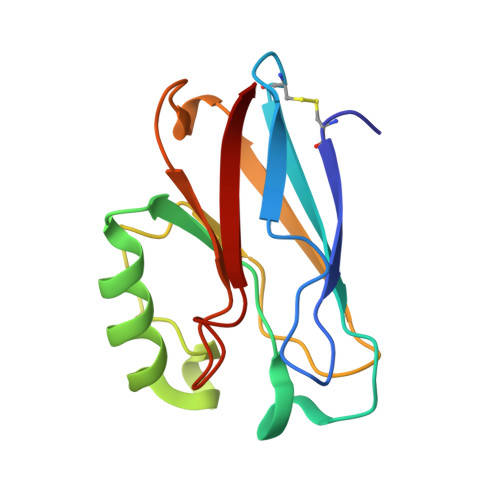The role of hydrogen bonding at the active site of a cupredoxin: the Phe114Pro azurin variant.
Yanagisawa, S., Banfield, M.J., Dennison, C.(2006) Biochemistry 45: 8812-8822
- PubMed: 16846224
- DOI: https://doi.org/10.1021/bi0606851
- Primary Citation of Related Structures:
2GHZ, 2GI0 - PubMed Abstract:
The Phe114Pro mutation to the cupredoxin azurin (AZ) leads to a number of structural changes at the active site attributed to deletion of one of the hydrogen bonds to the Cys112 ligand, removal of the bulky phenyl group from the hydrophobic patch of the protein, and steric interactions made by the introduced Pro. The remaining hydrogen bond between the coordinating thiolate and the backbone amide of Asn47 is strengthened. At the type-1 copper site, the Cu(II)-O(Gly45) axial interaction decreases, while the metal moves out of the plane formed by the equatorial His46, Cys112, and His117 ligands, shortening the bond to the axially coordinating Met121. The resulting distorted tetrahedral geometry is distinct from the trigonal bipyramidal arrangement in the wild-type (WT) protein. The unique position of the main S(Cys) --> Cu(II) ligand-to-metal charge-transfer transition in AZ (628 nm) has shifted in the Phe114Pro variant to a value that is more typical for cupredoxins (599 nm). This probably occurs because of the removal of the Phe114-Cys112 hydrogen bond. The Phe114Pro mutation results in a 90 mV decrease in the reduction potential of AZ, and removal of the second hydrogen bond to the Cys ligand seems to be the major cause of this change. The C-terminal His117 ligand does not protonate in the reduced Phe114Pro AZ variant, which suggests that none of the structural features altered by the mutation are responsible for the absence of this effect in the WT protein. Upon reduction, the copper displaces further from the equatorial ligand plane and the Cu-S(Met121) bond length decreases. These changes are larger than those seen in the WT protein and contribute to the order of magnitude decrease in the intrinsic electron-transfer capabilities of the Phe114Pro variant.
- Institute for Cell and Molecular Biosciences, Medical School, University of Newcastle upon Tyne, Newcastle upon Tyne NE2 4HH, United Kingdom.
Organizational Affiliation:

















